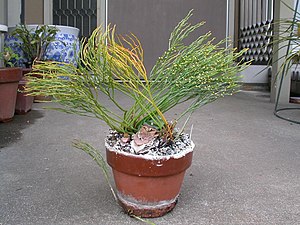Fork-leaf plants
| Fork-leaf plants | ||||||||||||
|---|---|---|---|---|---|---|---|---|---|---|---|---|

Psilotum nudum |
||||||||||||
| Systematics | ||||||||||||
|
||||||||||||
| Scientific name of the order | ||||||||||||
| Psilotales | ||||||||||||
| Prantl | ||||||||||||
| Scientific name of the family | ||||||||||||
| Psilotaceae | ||||||||||||
| JW handle. & Henfr. |
The Fork Leaf Family (Psilotaceae), also called Urfarne , are a family of the class Psilotopsida , which belongs to the ferns . Due to the lack of roots, their reduced leaves and the forked branches, they appear very primeval.
features
The fork-leaf family (Psilotaceae) are the least complex vascular plants of the recent land plants. The sporophyte is persistent and has no roots . It forms rhizomes on which rhizoids sit. The embryo also has no roots. The stem axis is low and dichotomously (forked) branched. There is no real dichotomy here; instead, in addition to the old vertex cell, a neighboring cell is determined to be the second vertex cell. The axis carries reduced leaves with or without a vascular bundle . The above-ground axes have an actinostele or almost a siphonostele, with the pulp being lignified.
The sporangia are large, their wall is two cell layers thick (eusporangiat). There is no annulus as an opening mechanism. Two to three sporangia are fused to form a synangium and appear to be on the adaxial (towards the shoot axis) side of a fork blade. A tapetum is missing. The spores are nourished by sterile Archespora cells.
The spores are all the same size (homospor), kidney-shaped, monolet (have a scar). There are too many (over 1000) formed per sporangium.
In Psilotum the gametophyte grows underground, is not photosynthetically active and feeds on the mycorrhiza . The gametophytes grow to a few centimeters and are cylindrical and branched. The antheridia sit on the surface and are multi-chambered, the spermatozoids are multi-flagellated. The archegonia are small and sunken. Strongly developed gametophytes have vascular bundles with lignified ring tracheids and an endodermis.
The basic chromosome number is x = 52.

distribution
The fork-leaf family occurs predominantly in the tropics and lives terrestrially or epiphytically .
Systematics
The systematic position of the fork-leaf plants was controversial for a long time. Sometimes they were even regarded as the basal group of vascular plants with the primeval ferns . However, molecular biological studies have clearly placed them on the ferns , where they form the sister group of the adder tongue family .
The family contains the two genera with about 12 species:
- Psilotum Sw. with two kinds. They preferentially occur in symbiosis with fungi ( mycorrhiza ). The plants have no leaves ; the photosynthesis takes place in the sprouts .
-
Tmesipteris Bernh. with at least 10 species. The species are often epiphytes on tree ferns of the genus Dicksonia . The shoot is surrounded by leaf-like scales up to 2 cm long. The genus is no longer run as a separate family Tmesipteridaceae. The following types are included (selection):
- Tmesipteris parva N.A. Wakef. : It was first described from Australia.
- Tmesipteris tannensis (Spreng.) Bernh. , Occurrence: Australia , Tasmania , New Zealand .
- Tmesipteris vieillardii P.A. Dang. , Occurrence: New Caledonia .
No fossils are known of the fork-leaf plants . On the basis of molecular clocks it was calculated that they had already separated from their sister group, the adder tongue family , in the carbon .
supporting documents
- Peter Sitte , Elmar Weiler , Joachim W. Kadereit , Andreas Bresinsky , Christian Körner : Textbook of botany for universities . Founded by Eduard Strasburger . 35th edition. Spektrum Akademischer Verlag, Heidelberg 2002, ISBN 3-8274-1010-X , p. 734 .
- Alan R. Smith, Kathleen M. Pryer, Eric Schuettpelz, Petra Korall, Harald Schneider, Paul G. Wolf: A classification for extant ferns. In: Taxon. Volume 55, No. 3, 2006, ISSN 0040-0262 , pp. 705-731, abstract, PDF file .
- John W. Thieret: Psilotaceae. In Flora of North America Editorial Committee (Ed.): Flora of North America North of Mexico . Volume 2: Pteridophytes and Gymnosperms . Oxford University Press, New York / Oxford a. a. 1993, ISBN 0-19-508242-7 , pp. 16-17 (English, limited preview in Google Book Search). on-line. (English)
Individual evidence
- ↑ a b Kathleen M. Pryer, Eric Schuettpelz, Paul G. Wolf, Harald Schneider, Alan R. Smith, Raymond Cranfill: Phylogeny and evolution of ferns (Monilophytes) with a focus on the early leptosporangiate divergences. In: American Journal of Botany. Volume 91, No. 10, 2004, pp. 1582-1598, doi: 10.3732 / ajb.91.10.1582 .
- ^ Alan R. Smith, Kathleen M. Pryer, Eric Schuettpelz, Petra Korall, Harald Schneider, Paul G. Wolf: A classification for extant ferns. In: Taxon. Volume 55, No. 3, 2006, ISSN 0040-0262 , pp. 705–731, abstract, ( Memento of the original dated February 12, 2017 in the Internet Archive ) Info: The archive link was inserted automatically and has not yet been checked. Please check the original and archive link according to the instructions and then remove this notice. PDF file .


